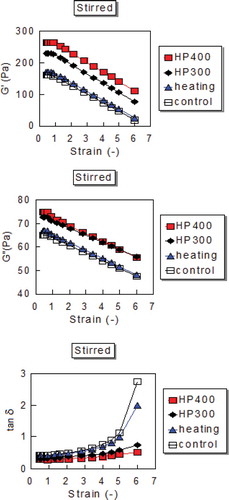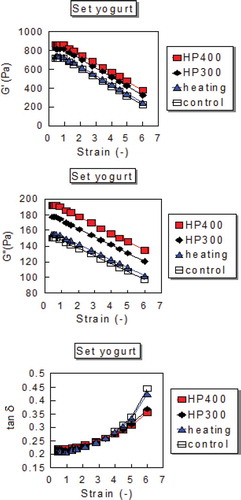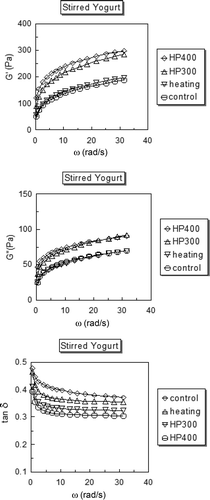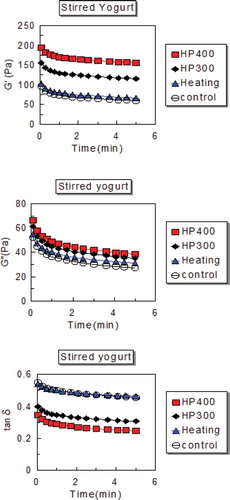Abstract
Viscoelastic properties of set and stirred yogurts made from raw (control), high pressure (300 and 400 MPa, 20 min, 4°C), and heat treated (80°C, 30 min) milks were investigated using a using a computer controlled rotational viscometer under oscillatory testing program, including three operating modes: a strain sweep, frequency sweep, and an isothermal time sweep. Linear, exponential, power-law, and Weltmann models were used to assess and describe the strain, frequency, and time dependent viscoelastic properties of yogurts. Their significance was analyzed using Duncan’s multiple range tests. The results indicated that the set yogurts had larger moduli (storage moduli G’ and loss moduli G”) and lower phase shift (tan δ) than stirred yogurts. High pressure treatment increased storage moduli G’ of both stirred and set yogurts significantly (p < 0.05). The influence on loss modulus was relatively lower. Unlike yogurts made from heat treated and raw milks, the ones made from pressure treated milks resulted in significantly different gel, frequency, and strain dependent properties for both types of yogurts. However, time dependent properties were not affected by pressure treatment.
Keywords:
INTRODUCTION
Increasing popularity has been reported in North America for low-fat milks and low-fat yogurt-based products due to growing concerns over nutrition and personal health.[Citation1,] Yogurt is mainly available in two forms: set-type and stirred type. The characteristic gel structure of the set-type of yogurts is allowed to form in containers during the fermentation/incubation phase, while in the stirred-type, the gel structure which is formed during bulk incubation is normally destroyed by agitation during cooling to give the product a smooth and semi-viscous flow behavior.[Citation2]
Generally, acidic milk gels are known to be viscoelastic materials. Many rheological studies have evaluated the textural dynamics properties of both set-type yogurts[Citation3,Citation4] and stirred yogurts.[Citation5−Citation8] The majority of studies on yogurt rheology were focused on empirically measured gel firmness and viscosity determination of stirred and set products and additionally, on affecting chemical composition such as fats, proteins, carbohydrates (lactose) content, and dry matter fortification.[Citation9−Citation14] Effects of different starter cultures on viscosity and microstructure of yogurt have also been described by several researchers.[Citation15−Citation18]
The high pressure (HP) treatment has well-known potential advantages over conventional heating systems.[Citation19] High-pressure treatment offers the dairy industry a new technique for food preservation. The conventional heat treatment is known to affect the quality of some yogurts as a result of destruction of thermo-labile indigenous microflora and heat sensitive native milk enzymes like lipase.[Citation20] It is generally accepted that vegetative microorganisms can be destroyed by high pressure and there has been some information available about inactivation kinetics of microorganisms in a complex system like milk or milk products.[Citation21] There is some data available about textural changes in the product due to high-pressure treatment.[Citation22−Citation25] High-pressure homogenization has been evaluated by several researchers either alone or in combination with thermal treatment. These studies suggest that HP homogenization in combination with thermal treatment can be used to improve the rheological properties and stability of yogurt, thus decreasing the need for additives. The rheological properties have been found to be influenced by the processing treatment, presence of additives like whey proteins, and pH. Thermal and HP treatment have not been found have additive effects; thermal treatment has been recognized to be more efficient in producing casein/protein interactions that were suitable for the formation of gels on acidification. It has also been found that the pressure-treated milk and yogurt has a much higher storage modulus, but yielded more readily to large deformation than the heated milk yogurt.[Citation11,Citation26] But there are fewer published studies available in literature on the effect of high pressure on the dynamic properties of set and stirred yogurts.[Citation18,Citation26] Static-pressure treatment is much milder as compared to the HP homogenization because of high shear and high temperature rise associated with the latter.
The objective of this research was further to evaluate the viscoelastic properties of both set and stirred yogurts made from the milks subjected to high pressure and conventional heating treatments, respectively; to develop the mathematical models of main viscoelastic properties such as storage module (G’), loss module (G”) and phase shift (tan δ) related to frequency (ω), strain (γ), and time (t), and to test the significant degree of difference between the model parameters under different treatment methods using Duncan’s multiple range tests.[Citation27,]
MATERIALS AND METHODS
Raw milk yogurt was made was from the milk obtained from the campus dairy farm (Faculty of Agricultural and Environmental Science, McGill University, QC, Canada). The Carnation brand (Nestle, 1185 Eglinton E., Don Mills, ON, Canada) skimmed milk power was obtained from a local super market. The mixed strain of freeze dried yogurt culture (Streptococcus thermophilus and Lactobacillus bulgaricus) was obtained from LYO-SAN Inc., Lachute, QC, Canada.
High Pressure Equipment
The equipment used for pressure treatment was an iso-static press (Model CIP 42260, ABB Autoclave System, Columbus, OH, USA) with a 4 L capacity chamber for holding the HP fluid and samples. The equipment has a cylindrical pressure chamber, 10 cm diameter and 56 cm high, and rated for operation up to a maximum pressure of 414 MPa. The high pressure medium was 2% mineral oil. The test product packaged in a flexible material was placed in the chamber, the stainless steel lid was lowered and secured by lid lock for further protection. A high-pressure pump was used to push the medium inside vessel to build-up the required level of pressure. Pressure release and sacrificial valves were used for discharging the pressure. To check the temperature of vessel and product, thermocouples were used and attached to a data logger and computer system. An external water circulation system was used to circulate the water around the HP chamber to maintain the chamber temperature at 4°C during the HP processing. The pressure come up time was 2 min for 300 MPa and 3 min for 400 MPa operating condition and the depressurization time was 15 s. The slow pressurization rate and rapid circulation of the cooling medium limited the temperature raise in the sample by no more than 5°C during the first five minutes.
Sample Preparation
Pre-treatment of raw milk
Raw milk was divided into four lots that were processed separately by four pre-treatments: Raw milk (untreated), HP 1 (400 MPa, 20 min), HP 2 (300 MPa, 20 min), and conventional heat (80°C, 30 min). All four types of milk samples were standardized to the same level of total milk solids using skim milk powder. Milk base mix was prepared having total milk solid 12% (fat 2% and non-fat milk solid 10%).The milk samples to be treated by high pressure were filled into 400 mL Dual Peel Sterilization Pouches purchased from Nasco (Nasco Plastics, 454 Bleams Road West, New Hamburg, ON, Canada). The pouches were sealed by using hand heat sealer.
Preparation of yogurt culture
Skim milk powder was dissolved in distilled water to get 10% milk solids and sterilized in an autoclave to destroy all the microbial species. The culture base mix was cooled to 42°C and inoculated with freeze dried yogurt culture and transferred into an incubator at 40°C for 4–5 h (until pH 4.6 was achieved). For making the yogurt, two tablespoons of yogurt culture was mixed with the base milk (approximately 2% by concentration).
Stirred yogurt fermentation
Part of the base milk was aseptically transferred into 1000 mL glass beakers, inoculated with the culture, sealed with aluminum covers, and incubated in a shaker waterbath (Thermo Electron Corporation, HAAKE C10, MA, USA) under medium agitation conditions, at 40°C, as proposed by starter manufacturer. Fermentation was stopped at a pH of 4.60 by rapidly cooling to 6°C and then samples were refrigerated at 4°C for subsequent analysis. The experiments were conducted in duplicate for each treatment.
Set yogurt fermentation
After disinfecting the Haake RV20 (Thermo Fisher Scientific Inc., MA, USA) rotation viscometer device with 80% ethanol, the outer cylinder (d = 32 mm) was inserted into the viscometer system and filled with approximately 50 mL of inoculated milk. The inner cylinder (d = 30 mm, h = 50 mm) was attached to the torque transducer and slowly lowered until the whole surface area of the bob was covered with milk. A small amount of sterile edible oil was added in order to avoid evaporation during incubation. The system was thermostatically controlled with a Haake F2 water bath/circulator.
Dynamic Rheological Methods
All measurements were made on a Haake RV20 rotation viscometer in sinusoidal oscillatory mode M5-osc with a frequency range from 0.05 to 5 Hz (0.314 to 31.4 rad/s) and a strain or deformation range from 2 to 10°. The measuring temperature was maintained at a constant 4°C by a recirculation water bath. Strain sweeps were conducted at a constant frequency of 3.14 rad/s, and strain amplitude ranged from 0.45 to 6. Frequency sweeps were conducted at a constant strain γ = 0.45 and frequency of oscillation ranged from 0.314˜31.4 rad/s. Isothermal time sweeps were conducted at constant ω = 3.14 rad/s, strain γ = 0.45. Each experiment was replicated two times.
RESULTS AND DISCUSSION
Strain Dependency
and show dynamic moduli and tan δ of both stirred and set yogurts made from milks treated by three different processing methods. From both figures, it can be easily found that the moduli (G’ and G”) of set yogurts are much greater than those of stirred yogurts, especially more evident for G’, while the tan δ of set yogurts was less than that of stirred yogurts. It indicated that set yogurt had more elastic properties than stirred yogurt.
From , it can be easily recognized that there are three distinct regions:
A constant region where G’ and G” were constant. This region was relatively small but evident. This shows the linear viscoelastic behavior range and indicates that of stirred yogurt in which G’ is greater than G”, it meant the yogurt has a predominantly elastic structure. Compared to the results reported in literature,[Citation9,Citation15] the linear viscoelastic region observed in this study is much narrower; this is due to the different strain range.
A linear decrease region where G’ and G” decreased with strain. The decrease rate of G′ was larger than that of G″, indicating a cross over point between G’ and G” curves, and the tan δ increased with strain. This is not evident from the separate plots of G’ and G”, but indicated by the tan δ value exceeding 1.0. This indicated that the full elastic structure of the material had broken down and the material has undergone transition from a predominantly elastic to a viscous structure.
The third region where G” is greater than G’ and tan δ is larger than one which meant that the yogurt behaved as a predominantly viscous fluid.
But from for set yogurt, it can be recognized that there are only two distinct regions: (1) the small constant region and (2) the linear decrease region. In the investigated strain range, there were no cross over points although the decrease rate of G’ was still larger than that of G” (meaning at some larger strain rates, there would be cross over, once the tissue structure is broken down). This indicates that the set yogurts have predominantly elastic properties in the investigated strain range.
From and , it can be found that both set and stirred yogurts made from different processing methods had the different size and change regularity of strain dependent properties. In order to determine the significance of effects of ultrahigh pressure and conventional heating on both set and stirred yogurt gels, the dependent strain linear regression models of G’, G” at decreasing region and tan δ at increasing region were developed and then the difference between models’ coefficients were tested by using Duncan’s multiple range tests. The results of regression analysis and Duncan’s multiple range tests are summarized in .
TABLE 1 Regression coefficients and Duncan’s multiple range tests of strain dependent for G′, G″, and tanδ in set and stirred yogurts subjected to different treatments
The R2 value of all regression equations () were greater than 0.9, meaning that linear model and exponential model can well fit strain dependent relationships of G’, G” and tan δ, respectively. From b0 results of Duncan’s multiple range tests in , it was found that both set and stirred yogurts had the same trends. For G’: the differences between all pairs were significant (p < 0.05); for G”: the difference was relatively smaller, there was significant difference only between HP400/heat and HP400/control. This showed that HP treatments can improve yogurt’s gel development significantly, especially elastic behavior, and the higher the pressure the greater increase can be observed.
From the b1 results of , it can be easily found that there were no significant differences (p > 0.05) between all the pairs of means except HP/control and HP/heat of both stirred yogurts G”, meaning that the treatment methods of milks did not affect the moduli—or the strain dependent properties of both set and stirred yogurt. For tan δ, the same trends of effects on the parameters A and B were found. There was significant difference (p < 0.05) between HP, heat and HP, control, but no significant difference (p > 0.05) was observed between HP400 and HP300. It implied that HP treatment of milk affected not only the size of phase shift, but also its strain dependent properties.
Frequency Dependency
shows the plots of G’, G”, and tan δ as a function of oscillation frequency at strain = 20 (i.e., in the linear region) for stirred yogurts; for set yogurts, similar plots were observed. The figure shows the typical gel behavior; G’ dominated G”, and the gel moduli increased non-linearly with increasing frequency over the investigated range; the tan δ decreased non-linearly with frequency. The power model (1) was chosen to fit frequency dependent region of G’ and G”, and the Weltmann model (2) to fit the relationships between tan δ and frequency (ω), respectively. The results of regression analysis and Duncan’s multiple range tests of model parameters are summarized in .
TABLE 2 Regression coefficients and Duncan’s multiple range tests of frequency dependency for G′, G″, and tanδ in set and stirred yogurts subjected to different treatments
Where ωm is the initial angular rate and it is equal to 0.314 rad/s. All R2 of regression equations () were greater than 0.92, indicating that the power model can well fit the relationships of G’ and G” related to frequency and the logarithmic frequency mode can well describe the phase shift tan δ decay behavior of frequency.
According to the results of Duncan’s range tests, it was found that for G’ and G” of both set and stirred yogurts, there were significant differences (p < 0.05) between all pairs of m and n mean values except heat and control, implying that HP treatments of milks had significant effects on G moduli of both set and stirred yogurts, and had the significant interactions with frequency, and moreover addition of pressure indicated enhancement of the effects. There were slightly different results with phase shift, tan δ. The differences between all A means were significant (p < 0.05) except heat and control; for coefficients B, but there were no differences (p > 0.05) between HP400 and HP300 and heat and control, the differences between other pairs of B means were still significant (p < 0.05). It implied that HP treatments of milks had same effects on tan δ of both set and stirred yogurts except that the addition of pressure didn’t change the decreasing rate of tan δ.
Time Dependency
An isothermal time sweep, where frequency and amplitude are constant, can indicate structural changes in thixotropic samples. Numbers of authors have characterized the time-dependent viscosity of yogurt products. The objective of this work was to develop the time dependent models using the related time dependent models and comparing the effects of high pressure and heat treatments on the model parameters.
The average viscoelastic properties for stirred yogurts as a function of time for three methods are shown in . The data clearly showed the time dependent viscoelastic behavior of both stirred and set yogurts. These results were in agreement with those in the reported papers. In order to compare the effects of different treatments of milks on time dependent properties, the Weltmann model was chosen for regression analysis of the data and the Duncan’s multiple range test was used to compare the differences between model’s parameters (A and B). For set type yogurts, graphs similar to the ones for stirred yogurts () were observed and the combined results are summarized in .
TABLE 3 Regression coefficients and Duncan’s multiple range tests for time dependency of G′, G″, and tan δ in set and stirred yogurts subjected to different treatments
The correlation coefficients of regression equations () were larger than 0.95, it indicated that the Weltmann model can well describe the viscoelastic properties of both stirred and set yogurts. From the results of Duncan’s multiple range tests, the following inferences were drawn: (1) for storage moduli G’, of both stirred and set yogurts, the treatment methods of milks had significant differences (p < 0.05) between all the pairs of A means, except control and heat, but no differences (p > 0.05) were observed between all the pairs of mean B values. It meant that HP treatment of milk increased G’ values significantly, but did not affect time dependent properties; (2) for G”, there were almost same superscript letters for both A means and B means. It showed that there were almost same time dependent properties for G” of both set and stirred yogurts, (3) for tan δ, trends similar to G’ were found. There were significant differences (p < 0.05) between all pairs of A except heat and control and no differences between B means were found, indicating that HP treatment didn’t affect the time dependency properties of both set and stirred yogurts.
CONCLUSIONS
The linear and the exponent models well describe the strain dependency of G’ and G”, and tan δ for both stirred and set yogurts, respectively. The power model and Weltmann model can well fit the frequency dependency of G’ and G” and phase shift tan δ; the isothermal time dependency of G’, G”, and tan δ can be fitted by the Weltmann model. The high pressure pre-treatments significantly affected the gel properties of both stirred and set yogurts, especially more evident to storage moduli and it was concluded that, the higher the pressure the larger is the increase in moduli values. High pressure treatment affected the frequency dependent properties and phase shift-strain dependent properties of both set and stirred yogurts significantly, but did not affect time dependent properties. There are no significant differences between dynamic properties of yogurts from raw and heat treated milk.
REFERENCES
- Eden, D.V. Growth of yogurt consumption by the American consumers. Cultured Dairy Products Journal 1988, 23 (4), 26.
- Tamine, A.Y.; Robinson, R.K. Yogurt: Science and Technology. Pergamon Press: Oxford, U.K., 1985.
- Rohm, H. Viscosity determination of stirred yogurt. Journal of Food Science and Technology 1992, 25, 297–301.
- Guzel-Seydim, Z.B.; Sezgin, E.; Seydim, A.C. Influences of exopolysaccharide producing cultures on the quality of plain set type yogurt. Food Control 2005, 16 (3), 205–209.
- Ramaswamy, H.S.; Basak, S. Rheology of stirred yogurts. Journal of Texture Studies 1991, 22, 231–241.
- Ramswamy, H.S.; Basak, S. Time dependent stress decay rheology of stirred yogurt. International Dairy Journal 1992, 2, 17–31.
- Keogh, M.K.; O’Kennedy, B.T. Rheology of stirred yogurt as affected by added milk fat, protein and hydrocolloids. Journal of Food Science 1998, 63 (1), 108–112.
- Lubbers, S.; Decourcelle, N.; Vallet, N.; Guichard, E. Flavor release and rheology behavior of strawberry fat free stirred yogurt during storage. Journal of Agricultural and Food Chemistry 2004, 52 (10), 3077–3082.
- Rohm, H. Influence of dry matter fortification on flow properties of yogurt. 2. Time dependent behavior. Milchwissenschaft–Milk Science International 1993, 48, 614–617.
- Oliveira, M.N.; Sodini, I.; Remeuf, F.; Corrieu, G. Effect of milk supplementation and culture composition on acidification, textural properties and microbiological stability of fermented milks containing probiotic bacteria. International Dairy Journal 2001, 11 (11–12), 935–942.
- Harte, F.; Amonte, M.; Luedecke, L.; Swanson, B.G.; Barbosa-Cánovas, G.V. Yield stress and microstructure of set yogurt made from high hydrostatic pressure-treated full fat milk. Journal of Food Science 2002, 67 (6), 2245–2250.
- Krzeminski, A.; Großhable, K.; Hinrichs, J. Structural properties of stirred yoghurt as influenced by whey proteins. YFSTL LWT - Food Science and Technology 2011, 44 (10), 2134–2140.
- Kök, M.S. Characterization of galactomannan stabilised yogurt drink using dynamic rheology. International Journal of Food Properties 2010, 13 (1), 209–220.
- Domagała, J.; Sady, M.; Grega, T.; Bonczar, G. Rheological properties and texture of yoghurts when oat-maltodextrin is used as a fat substitute. International Journal of Food Properties 2006, 9 (1), 1–11.
- Rohm, H.; Kovac, A. Effects of starter cultures on linear viscoelastic and physical properties of yogurt gels. Journal of Texture Studies 1994, 25, 311–329.
- Hassan, A.N.; Ipsen, R.; Janzen, T.; Qvist, K.B. Microstructure and rheology of yogurt made with cultures differing only in their ability to produce exopolysaccharides. Journal of Dairy Science 2003, 86 (5), 1632–1638.
- Sodini, I.; Remeuf, F.; Haddad, S.; Corrieu, G. The relative effect of milk base, starter, and process on yogurt texture: a review. Critical reviews in Food Science and Nutrition 2004, 44 (2), 113–137.
- Penna, A.L.B.; Gurram, S.; Barbosa-Canovas, G.V. Effect of high hydrostatic pressure processing on rheological and textural properties of probiotic low-fat yogurt fermented by different starter cultures. Journal of Food Process Engineering 2006, 29 (5), 447–461.
- Ledward, D.A.; Johnston, D.E.; Earnshaw, R.G.; Hasting, A.P.M. High Pressure Processing of Foods. Nottingham University Press: Nottingham, 1995.
- Pandey, P.K.; Ramaswamy, H.S. Effect of high pressure treatment of milk on lipase and g-glutamyl transferase activity. Journal of Food Biochemistry 2004, 28, 449–462.
- Hinrichs, J.; Rademacher, B.; Kessler, H.G. 1995. Food processing of milk products with ultrahigh pressure. Proceedings of the IDF Symposium Heat Treatments and Alternative Methods; Vienna (Austria), September 6–8, 1995.
- Serra, M.; Trujillo, A.J.; Quevedo, J.M.; Guamis, B.; Ferragut, V. Acid coagulation properties and suitability for yogurt production of cows’ milk treated by high-pressure homogenisation. International Dairy Journal 2007, 17 (7), 782–790.
- Cruz, N.S.; Capellas, M.; Jaramillo, D.P.; Trujillo, A.J.; Guamis, B.; Ferragut, V. Soymilk treated by ultra high-pressure homogenization: Acid coagulation properties and characteristics of a soy-yogurt product. Food Hydrocolloids 2009, 23 (2), 490–496.
- Ferragut, V.; Cruz, N.S.; Trujillo, A.; Guamis, B.; Capellas, M. Physical characteristics during storage of soy yogurt made from ultra-high pressure homogenized soymilk. Journal of Food Engineering 2009, 92 (1), 63–69.
- Ciron, C.I.E.; Gee, V.L.; Kelly, A.L.; Auty, M.A.E. Effect of microfluidization of heat-treated milk on rheology and sensory properties of reduced fat yoghurt. Food Hydrocolloids 2011, 25 (6), 1470–1476.
- Walsh-O Grady, C.D.; O Kennedy, B.T.; Fitzgerald, R.J.; Lane, C.N. A rheological study of acid-set “simulated yogurt milk” gels prepared from heat- or pressure-treated milk proteins. Dairy Science and Technology 2001, 81, 637–650.
- Douglas, C.M. Design and Analysis of Experiments, 4th Ed; John Wiley & Sons: New York, 1997.




